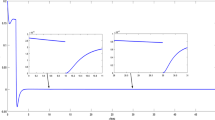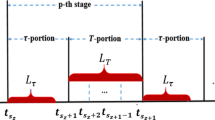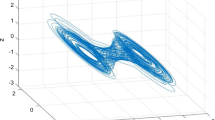Abstract
In this paper, the problems of finite-time stability analysis and finite-time stabilization are investigated for Markovian jump linear systems with incomplete transition descriptions. Two sufficient conditions are proposed to guarantee that the system states do not exceed a certain threshold in mean-square sense during a specified time interval for the continuous-time Markovian jump linear systems with partly unknown transition rates and the discrete-time Markovian jump linear systems with partly unknown transition probabilities, respectively. On the basis of the above results, two state feedback controllers are developed to solve the finite-time stochastic stabilization problems of the considered systems in continuous-time domain and discrete-time domain, respectively. For the sake of computational convenience, all the conditions are cast in the format of linear matrix inequalities (LMIs). The main feature of the proposed methods is that the total number of LMIs is much less than that in some existing results. Thus, the solution of the finite-time controllers is more concise both in theory and in engineering. In the end, the validity of the developed theoretical results are demonstrated by two illustrative examples.
Similar content being viewed by others
References
J. Cheng, B. Wang, and J. H. Park, “Sampled-data reliable control for T-S fuzzy semi-Markovian jump system and its application to single-link robot arm model,” IET Control Theory and Applications, vol. 11, no. 12, pp. 1904–1912, August 2017.
Y. M. Fu and C. J. Li, “Parametric method for spacecraft trajectory tracking control problem with stochastic thruster fault,” IET Control Theory and Applications, vol. 10, no. 17, pp. 2331–2338, November 2016.
P. Shi, F. B. Li, and L. G. Wu, “Neural network-based passive filtering for delayed neutral-type semi-Markovian jump systems,” IEEE Transactions on Neural Networks & Learning Systems, vol. 28, no. 9, pp. 2101–2114, 2017.
I. Ghous, Z. R. Xiang, and H. R. Karimi, “H∞ control of 2-D continuous Markovian jump delayed systems with partially unknown transition probabilities,” Information Sciences, vol. 382, pp. 274–291, March 2017.
D. Y. Yao, R. Q. Lu, and H. R. Ren, “Sliding mode control for state-delayed Markov jump systems with partly unknown transition probabilities,” Nonlinear Dynamics, vol. 91, no. 1, pp. 475–486, January 2018.
X. L. Luan, B. Huang, and F. Liu, “Higher order moment stability region for Markov jump systems based on cumulant generating function,” Automatica, vol. 93, pp. 389–396, July 2018.
S. Y. Pan, Z. Y. Ye, and J. Zhou, “Fault detection filtering for a class of nonhomogeneous Markov jump systems with random sensor saturations,” International Journal of Control Automation and System, vol. 18, no. 2, pp. 439–449, February 2020.
P. Bolzern, P. Colaneri, and N. G. De, “On almost sure stability of continuous-time Markov jump linear systems,” Automatica, vol. 42, no. 6, pp. 983–988, June 2006.
H. Shen, J. H. Park, and Z. G. Wu, “Finite-time synchronization control for uncertain Markov jump neural networks with input constraints,” Nonlinear Dynamics, vol. 77, no. 4, pp. 1709–1720, September 2014.
O. L. V. Costa and E. F. Tuesta, “Finite horizon quadratic optimal control and a separation principle for Markovian jump linear systems,” IEEE Transactions on Automatic Control, vol. 48, no. 10, pp. 1836–1842, October 2003.
S. P. He and H. L. Xu, “Non-fragile finite-time filter design for time-delayed Markovian jumping systems via T-S fuzzy model approach,” Nonlinear Dynamics, vol. 80, no. 3, pp. 1159–1171, May 2015.
C. C. Ren, S. P. He, and X. L. Luan, “Finite-time L-gain asynchronous control for continuous-time positive hidden Markov jump systems via T-S fuzzy model approach,” IEEE Transactions on Cybernetics, vol. 99, no. 1, pp. 1–11, June 2020.
X. L. Luan, F. Liu, and P. Shi, “Finite-time stabilization of stochastic systems with partially known transition probabilities,” Journal of Dynamic Systems Measurement and Control-transactions of the ASME, vol. 133, no. 1, pp. 504–510, January 2011.
Z. T. Wu, L. J. Yang, and B. P. Jiang, “Finite-time H-infinity control of stochastic singular systems with partly known transition rates via an optimization algorithm,” International Journal of Control Automation and System, vol. 17, no. 6, pp. 1462–1472, July 2019.
G. D. Zong, Y. Dong, and L. L. Hou, “Robust finite-time H∞ control for Markovian jump systems with partially known transition probabilities,” Journal of the Franklin Institute, vol. 350, no. 6, pp. 1562–1578, August 2013.
Y. Zhang, Y. He, and M. Wu, “Stabilization for Markovian jump systems with partial information on transition probability based on free-connection weighting matrices,” Automatica, vol. 47, no. 1, pp. 79–84, January 2011.
Z. Zuo, Y. Liu, and Y. Wang, “Finite-time stochastic stability and stabilisation of linear discrete-time Markovian jump systems with partly unknown transition probabilities,” IET Control Theory & Applications, vol. 6, no. 10, pp. 1522–1526, July 2012.
L. X. Zhang and L. James, “Necessary and sufficient conditions for analysis and synthesis of Markov jump linear systems with incomplete transition descriptions,” IEEE Transactions on Automatic Control, vol. 55, no. 7, pp. 1695–1701, July 2010.
W. Zhang and H. Liu, “Finite-time control of stochastic Markovian jump systems,” Control Theory and Applications, vol. 32, no. 3, pp. 334–340, June 2015.
M. Q. Shen and Y. H. Yuan, “Finite-time stabilization of discrete Markov jump systems with partly known transition probabilities,” Proc. of International Conference on Mechatronics and Control, pp. 2420–2424, 2015.
H. J. Sun, Y. Zhang, and A. G. Wu, “Stochastic stability analysis of Markovian jump linear systems with incomplete transition descriptions,” IET Control Theory and Applications, vol. 12, no. 14, pp. 1974–1982, 2018.
F. Amato, M. Ariola, and P. Dorato, “Finite-time control of linear systems subject to parametric uncertainties and disturbances,” Automatica, vol. 37, no. 9, pp. 1459–1463, September 2001.
H. Wang, and Q. X. Zhu, “Finite-time stabilization of high-order stochastic nonlinear systems in strict-feedback form,” Automatica, vol. 54, pp. 284–291, April 2015.
Z. G. Yan, J. H. Park, and W. H. Zhang, “Finite-time guaranteed cost control for Itô stochastic Markovian jump systems with incomplete transition rates,” International Journal of Robust and Nonlinear Control, vol. 27, no. 1, pp. 66–83, January 2017.
Y. C. Ma, X. R. Jia, and Q. L. Zhang, “Robust observer-based finite-time H∞ control for discrete-time singular Markovian jumping system with time delay and actuator saturation,” Nonlinear Analysis: Hybrid Systems, vol. 28, no. 5, pp. 1–22, May 2018.
X. R. Mao, “Stability of stochastic differential equations with Markovian switching,” Stochastic Processes and their Applications, vol. 79, no. 1, pp. 45–67, January 1999.
Author information
Authors and Affiliations
Corresponding author
Additional information
Publisher’s Note Springer Nature remains neutral with regard to jurisdictional claims in published maps and institutional affiliations.
This work was supported by National Key Research and Development Program of China under Project No.2018AAA0100102, by National Natural Science Foundation of China under Grant Nos.61903103, 61822305, 61690210 and 61690213, by Guangdong Natural Science Foundation under Grant No.2019A1515011576.
Yuzhu Bai received his Ph.D. degree in aerospace engineering from National University of Defense Technology, China, in 2011. He is currently an associate professor at National University of Defense Technology, China. His current research interests include micro-satellite design, spacecraft dynamics and control.
Hui-Jie Sun was born in Inner Mo, P. R. China on August 02, 1988. He received a B.Eng. degree in automation in July 2011 from Harbin Institute of Technology, M.Eng. degree in January 2014 and Ph.D. degree in October 2018 in control science and engineering from Harbin Institute of Technology, Shenzhen. Dr. Sun was a postdoctoral researcher with the School of Electronics and Information Engineering, Harbin Institute of Technology, Shenzhen, from December 2018 to November 2020. He is currently an Assistant Professor in Sun Yat-sen University. His current research interests include stochastic systems, iterative algorithms, neural networks and spacecraft control.
Ai-Guo Wu was born in Gong’an County, Hubei Province, P. R. China on September 20, 1980. He received his B.Eng. degree in automation in July 2002, M.Eng. degree in navigation, guidance and control in July 2004 and Ph.D. degree in control science and engineering in Nov. 2008 all from Harbin Institute of Technology. In Oct. 2008, he joined Harbin Institute of Technology Shenzhen Graduate School as an assistant professor, and in August 2012 he was promoted to a professor. From Jan. 2018, he is a professor in Harbin Institute of Technology, Shenzhen. Dr. Wu was a Research Fellow with the Department of Manufacturing Engineering and Engineering Management, City University of Hong Kong from March 2009 to March 2011. He was a visiting professor with the Department of Electrical, Electronic and Computer Engineering of The University of Western Australia, Australia from July 2013 to July 2014. His research interests include descriptor systems, conjugate product of polynomials, switched system and robust control. He has authored/coauthored one English monograph and more than 80 SCI journal papers. He received the National Natural Science Award (Second Prize) in 2015 from P. R. China, and the National Excellent Doctoral Dissertation Award in 2011 from the Academic Degrees Committee of the State Council and the Ministry of Education of P. R. China. He was supported by the Program for New Century Excellent Talents in University in 2011, and by the National Natural Science Foundation of China for Excellent Young Scholars in 2018. Dr. Wu is a reviewer for American Mathematical Review from 2007. He serves as a Regional Editor of Nonlinear Dynamics and Systems Theory from 2015, and an International Subject Editor of Applied Mathematical Modelling from 2017. He was an Outstanding Reviewer for IEEE Transactions on Automatic Control in 2010.
Rights and permissions
About this article
Cite this article
Bai, Y., Sun, HJ. & Wu, AG. Finite-time Stability and Stabilization of Markovian Jump Linear Systems Subject to Incomplete Transition Descriptions. Int. J. Control Autom. Syst. 19, 2999–3012 (2021). https://doi.org/10.1007/s12555-020-0505-7
Received:
Revised:
Accepted:
Published:
Issue Date:
DOI: https://doi.org/10.1007/s12555-020-0505-7




